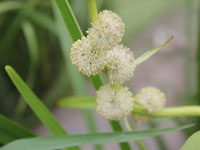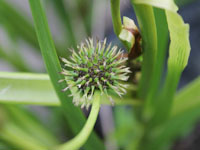![]()
Sparganium americanum, commonly known as American bur-reed, is a perennial plant native to Eastern North America. Although it may initially resemble a grass, it belongs to the bur-reed family. This plant plays a vital role in conservation due to its ability to remove nitrogen and phosphorus from water, similar to many other wetland species. By absorbing these nutrients, American bur-reed helps protect waterways from the harmful effects of excess nitrogen, which can lead to eutrophication—a condition that depletes oxygen in aquatic ecosystems and harms aquatic life. This issue is particularly significant during the agricultural growing season, when fertilizers rich in nitrogen are applied to crops. As these fertilizers contribute to nitrogen runoff into groundwater, American bur-reed grows actively and absorbs the excess nitrogen, mitigating its impact on the environment.
The genus name Sparganium is thought to originate from the Greek word sparganon, meaning "a band," likely referring to the plant’s strap-like leaves. The common name, American bur-reed, derives from the distinctive "burred" seed pods that develop after the plant flowers. These features make American bur-reed not only ecologically important but also uniquely identifiable in its natural habitat.
![]()
American Bur-Reed currently does not have any commercial applications. However, in the natural world, the roots American bur-reed plant create stability along the shores of waterways and wetlands, and many types of water fowl feed on the seeds and foliage.
![]() Within the realm of naturopathic medicine and folklore, American bur-reed does not have any known medicinal value.
Within the realm of naturopathic medicine and folklore, American bur-reed does not have any known medicinal value.
Please note that MIROFOSS does not suggest in any way that plants should be used in place of proper medical and psychological care. This information is provided here as a reference only.
![]()
The roots and stems of American bur-reed are considered to be edible.
Please note that MIROFOSS can not take any responsibility for any adverse effects from the consumption of plant species which are found in the wild. This information is provided here as a reference only.
![]()
American bur-reed can grow in low marsh and shallow water, surviving in water up to 30cm deep. This species helps stabilize muddy areas and shorelines. American bur-reed live in peaty to sandy soils along lakeshores, slow moving streams and as floating vegetation in boggy lakes. The plant can survive in partial or full sun but is not drought tolerant and must stay in wet soil or submerged in water.
| Soil Conditions | |
| Soil Moisture | |
| Sunlight | |
| Notes: |
![]()
American Bur-Reed is a monocot plant only having one seed leaf. Individual American bur-reeds can grow to be between 30cm to 200cm tall. American bur-reed plants produce white, rounded cluster, flowers during the summer months. The flower pedals could have a dark spot on them which may give the appearance of a darker flower. The flowers of the American bur-reed are monoecious meaning that individual flowers are either male or female and both sexes can be found on the same plant. American bur-reed flowers are pollinated by Wind. The leaves of the American bur-reed are acicular, green, and are triangular in cross section; the leaves of individuals plants living in deeper water can produce floating leaves. American bur-reed spread rapidly through their underground root systems of rhizomes. The fruit found on American bur-reed have a dull surface with beaks that are between 2 and 5 millimeters long. These beaks may be straight, but some of them may be curved. It should be noted that before the flowers or fruits are visible on the American bur-reed, the plant may be misidentified as a grass.
![]()
| Plant Height | 30cm to 200cm | 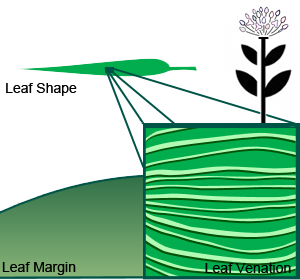 |
| Habitat | Shallow water and Muddy Shorelines | |
| Leaves | Subulate with a triangular cross section | |
| Leaf Margin | Entire (Smooth) | |
| Leaf Venation | Parallel | |
| Stems | Zigzag stalks | |
| Flowering Season | May to August | |
| Flower Type | Rounded Clusters of scales | |
| Flower Colour | White, sometimes with dark spots | |
| Pollination | Wind | |
| Flower Gender | Female flowers (one stigma) Male flowers (five stamens) | |
| Fruit | Seed-like green bur-like heads | |
| USDA Zone | 5A (-26.2°C to -28.8°C) cold weather limit |
![]()
No known health risks have been associated with American bur-reed. However ingestion of naturally occurring plants without proper identification is not recommended.
![]()
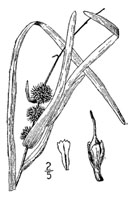 |
-Click here- or on the thumbnail image to see an artist rendering, from The United States Department of Agriculture, of American Bur-Reed. (This image will open in a new browser tab) |
![]()
 |
-Click here- or on the thumbnail image to see a magnified view, from The United States Department of Agriculture, of the seeds created by the American bur-reed for propagation. (This image will open in a new browser tab) |
![]()
American bur-reed can be translated into the following select languages:
| Arabic | الأمريكي بر-القصب | Bulgarian | American Бур-тръстика | Chinese (Sim) | 美国车针簧 |
| Croatian | Američki Bur-Reed | Czech | Americký bur-rákos | Danish | Amerikansk bur-reed |
| Dutch | Amerikaanse bur-riet | Esperanto | Amerika Bur-reed | Estonian | American bur-pilliroog |
| Finnish | Amerikkalainen bur-ruoko | French | Amérique rubanier | German | Amerikanischen Igelkolben |
| Greek | Αμερικανός τραχεία καλάμι | Hebrew | אמריקנית ספחת-ריד | Hungarian | American Bur-nád |
| Italian | Americano bur-canna | Japanese | アメリカンいが、葦 | Korean | 미국 버 - 리드 |
| Punjabi | Lithuanian | Amerikos BUR-nendrių | Norwegian | American bur-siv | |
| Persian | آمریکا فرز نی | Polish | Amerykańska bur-trzciny | Portuguese | Americana bur-reed |
| Romanian | Russian | Американский бор-трость | Slovak | Americký bur-trstina | |
| Spanish | Americana bur-reed | Swedish | Amerikansk bur-reed | Tagalog | Amerikano tinik-tambo |
| Turkish | Amerikan bur-kamış | Ukrainian | Американський бор-тростина | Vietnamese | Mỹ bur-sậy |

![]()
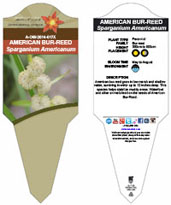 |
The MIROFOSS database offers free printable garden tags for personal and non-profit use. These tags can be used to properly identify plant samples in a garden. Click on the tags shown on the the screen or -click here- to download a full size jpeg image for an American Bur-Reed identification tag; which can be printed on paper or used with a plastic laser printer. |
 |
What's this? What can I do with it? |
![]()
| Description / Application | USDA-NRCS PLANTS Database / Britton, N.L., and A. Brown. 1913. An illustrated flora of the northern United States, Canada and the British Possessions. 3 vols. Charles Scribner's Sons, New York. Vol. 1: 70. |
| Description | Sulman, Josh. 2013. Sparganium identification key and species descriptions. University of Wisconsin-Madison, Department of Botany. |
| Biology | Kao, Jenny T., John E. Titus, and Wei-Xing Zhu. 2003. Differential Nitrogen and Phosphorus Retention by Five Wetland Plant Species. Wetlands Vol. 23, No. 4: 979-987. |
| Biology | Kartesz, J.T. 1994. A synonymized checklist of the vascular flora of the United States, Canada, and Greenland. 2nd edition. 2 vols. Timber Press, Portland, OR. |
| Biology | Dickinson, T.; Metsger, D.; Bull, J.; & Dickinson, R. (2004) ROM Field Guide to Wildflowers of Ontario. Toronto:Royal Ontario Museum, |
| Image Rendering | USDA-NRCS PLANTS Database / USDA NRCS. Wetland flora: Field office illustrated guide to plant species. USDA Natural Resources Conservation Service. |
| Environment | National Audubon Society. Field Guide To Wildflowers (Eastern Region): Alfred A. Knopf. ISBN 0-375-40232-2 |
| Physical Identification | National Audubon Society. Field Guide To Wildflowers (Eastern Region): Alfred A. Knopf. ISBN 0-375-40232-2 |
| January 31, 2015 | The last time this page was updated |
| ©2025 MIROFOSS™ Foundation | |
 |
|

